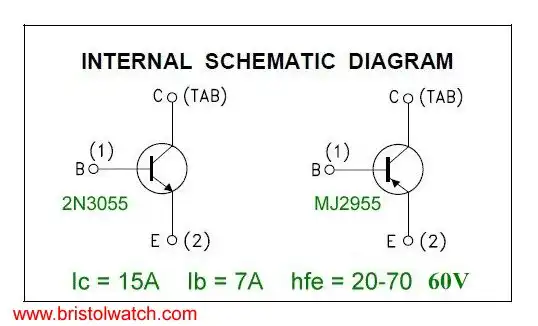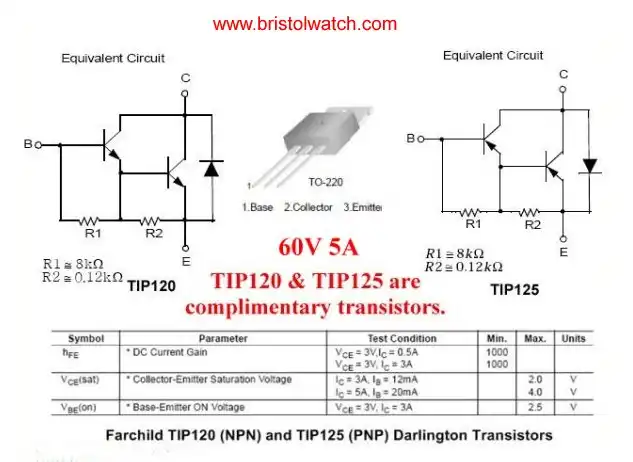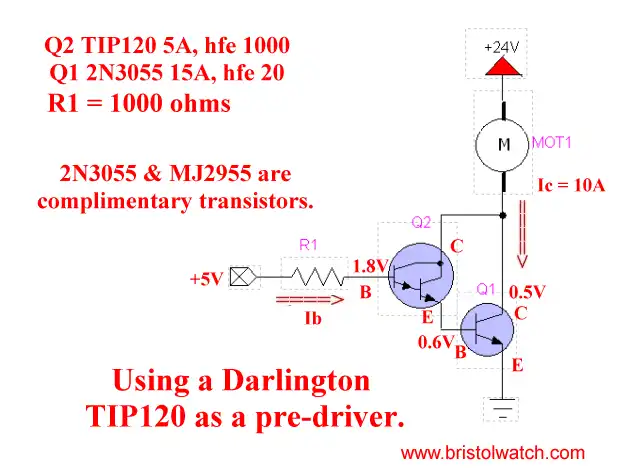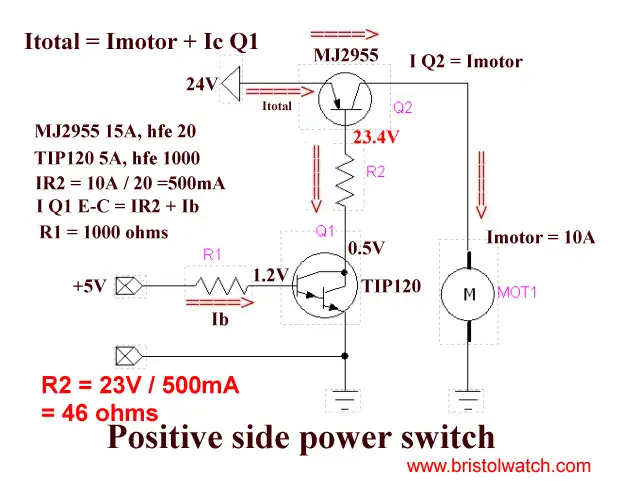
Plate 1 2N3055-Mj2955 Complementary silicon power transistors.
Using Darlington Transistors Driving 2N3055-MJ2955 Power Transistors
2N3055 (NPN), MJ2955 (PNP): Complementary silicon power transistors are designed for general-purpose switching and amplifier applications. They can carry an impressive 15 Amps of collector current making them ideal for high power switching applications such as motor drivers for use in power inverters.
But they suffer two problems that plague most high-power bipolar transistors - low hfe or DC current gain. That means they can be directly connected to micro-controllers due to high drive currents required and in the case of the MJ2955 high voltage on the base can't connect directly to 5-volt TTL logic.

Plate 2 2N3055 transistor switch must have pre-driver.
This problem is illustrated in plate 2 with the 2N3055 driving a 10 Amp DC motor. The low hfe of 20 means we require a base-emitter current of at least 500mA - far above the limit of most micro-controller I/O pins limited to 20-40mA. We must have a pre-driver.

Plate 2
An excellent choice for a pre-drivers for both the 2N3055 and Mj2955 are the TIP120 and TIP125 complementary Darlington power transistors. While rated at 5 Amps collector current they can provide the needed current gain and voltage isolation for the PNP Mj2955. Plate provides the basic data for the TIP120 and TIP125 power Darlington transistors.

Plate 3
In plate 3 we use a TIP120 NPN Darlington to drive a 2N3055 NPN power transistor. Variations of the above circuits are used to construct H-Bridge motor controls, relay and contactor drivers, etc.

Plate 4
In plate 4 we have a power TIP120 Darlington driving an even higher power Mj2955 PNP transistor. An additional benefit is isolating the 23 volts on the base of Q2 form the 5-volt TTL logic.
- Quick navigation of this website:
- Basic Electronics Learning and Projects
- Basic Solid State Component Projects
- Arduino Microcontroller Projects
- Raspberry Pi Electronics, Programming
- ULN2003A Darlington Transistor Array with Circuit Examples
- Tutorial Using TIP120 and TIP125 Power Darlington Transistors
- Driving 2N3055-MJ2955 Darlington Transistors
- Understanding Bipolar Transistor Switches
- N-Channel Power MOSFET Switching Tutorial
- P-Channel Power MOSFET Switch Tutorial
- H-Bridge Motor Control with Power MOSFETs
- Arduino Controlled IR2110 Based H-Bridge HV Motor Control
- IGBT Based High Voltage H-Bridge DC Motor Control
- More Power MOSFET H-Bridge Circuit Examples
- Build a High Power Transistor H-Bridge Motor Control
- Related:
- N-Channel Power MOSFET Switching Tutorial
- P-Channel Power MOSFET Switch Tutorial
- Test Power MOSFET Transistors, Observations
- Issues on Connecting MOSFETs in Parallel
- Basic MOSFET Transistor Test Circuits
- High Voltage MOSFET Switching Circuits
- Why Your MOSFET Transistors Get Hot YouTube
- Issues on Connecting MOSFETs in Parallel YouTube
- Simple Circuits for Testing MOSFET Transistors YouTube
See the following spec sheets:
- Basic Triacs and SCRs
- Constant Current Circuits with the LM334
- LM334 CCS Circuits with Thermistors, Photocells
- LM317 Constant Current Source Circuits
- TA8050P H-Bridge Motor Control
- All NPN Transistor H-Bridge Motor Control
- Basic Triacs and SCRs
- Comparator Theory Circuits Tutorial
Web site Copyright Lewis Loflin, All rights reserved.
If using this material on another site, please provide a link back to my site.